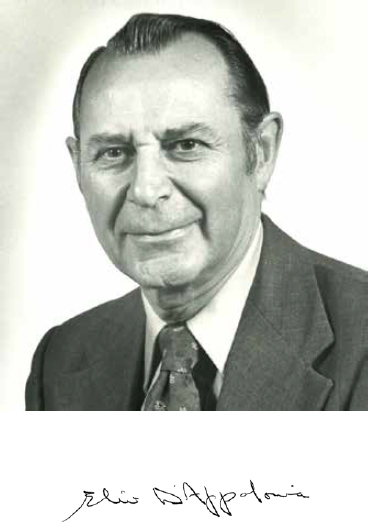This page intentionally left blank.

ELIO D’APPOLONIA
1918–2015
Elected in 1977
“Contributions to design and construction procedures for foundations of complex facilities subjected to heavy loadings.”
ELIO D’APPOLONIA died December 30, 2015, after a long career that made him known around the world for his pioneering work in the area of dams and tailings disposal, heavily loaded foundations for industrial facilities, and the best ways to accomplish such work.
Born April 14, 1918, to Italian immigrants in Crow’s Nest Pass near Coleman, Alberta, Canada, D’App, as he was called, developed a lifelong passion for hockey and hoped to play professionally. But his father wisely put him to work in his construction company and then encouraged him to enter college. D’App received bachelor’s (1942) and master’s degrees (1946) in civil engineering from the University of Alberta. During the summers in 1942–46, he worked for the US Army Corps of Engineers on the engineering and construction of foundations, airfields, and highways on permafrost in northern Canada and Alaska.
In January 1939 he met his future wife, Violet Mary (nicknamed Tina), in Edmonton. They married May 2, 1942, and went on to have five children.
In the summer of 1946 D’App moved his young family to Illinois, where he completed his doctorate (1948) at the University of Illinois at Urbana-Champaign, working with an early version of the finite element analysis method. They then
moved to Pittsburgh, where he devoted the next eight years to teaching and research at the Carnegie Institute of Technology (now Carnegie Mellon University, CMU). His interest and training, primarily in structural engineering and applied mechanics, expanded to soil mechanics and foundation engineering when he was asked to fill this void in the CMU curriculum. This came to dominate his professional interests for the remainder of his life.
In 1950 he started a part-time consultancy on projects involving structural and soil mechanics problems. But after several heart attacks and his doctor’s orders to pick the least stressful between teaching and consulting, in 1956 D’App stepped down as a full professor to start the consulting engineering practice that became Elio D’Appolonia Consulting Engineers (EDCE).
EDCE grew and flourished to become an internationally renowned leader in geotechnical engineering, a multifaceted group of companies providing geotechnical engineering, construction, and related environmental and Earth science services to both private industry and government agencies. D’App embraced challenging and difficult clients and projects and found creative solutions for them. His many projects included the foundation, design, and construction for the New Bethlehem Steel Manufacturing Facility in Burns Harbor, Indiana; the construction of a nuclear power plant on a deep fill in Italy for Enel; and resolution of unexpected foundation movements that affected construction of the velodrome for the 1976 Olympics in Montreal. He was also a member of the Board of Construction during the construction of the Merrill Creek Dam in northwestern New Jersey.
D’App made seminal contributions to the fields of geotechnical and foundation engineering. He authored numerous technical papers and served on many committees in professional societies, often as chair. Honors in recognition of his achievements include the American Society of Civil Engineers (ASCE) Thomas A. Middlebrooks Award (1969, shared with his son David) and 24th Karl Terzaghi Lecture (1988), election to the NAE in 1977, and honorary doctorates from CMU and




